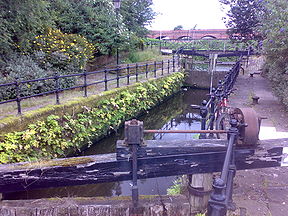- Manchester and Salford Junction Canal
-
Manchester and Salford Junction Canal The canal stub viewed north towards the junction with the River Irwell Original owner Mersey and Irwell Navigation Company Principal engineer John Gilbert Date of first use 1839 Date closed 1922 Connects to Rochdale Canal Locks 4 Status Closed The Manchester and Salford Junction Canal was a canal in the city of Manchester. It was originally built to provide a direct waterway between the Mersey and Irwell Navigation and the Rochdale Canal. The canal opened in 1839 and was abandoned in 1922.
Contents
History
The lack of any direct canal link between the Mersey and Irwell Navigation (M&IN) and the Rochdale Canal meant that goods being transported using both waterways had to be offloaded onto carts and carried across the city, before being loaded back onto boats to continue their journey. This was costly and time-consuming, as well as adding to traffic congestion on the streets of Manchester.
In 1799 the nearby Manchester Bolton & Bury Canal company (MB&B) proposed to connect their canal[1] to the Rochdale canal with an aqueduct across the M&IN. Due mainly to strong objections from the M&IN, who would have suffered a loss of trade, the link was not forthcoming.[2] In 1805, John Nightingale was asked by the Mersey and Irwell Navigation Company to estimate the cost of a canal link between Manchester and Salford.
Nothing would happen until 1836, when John Gilbert was appointed as engineer. In 1838, just as the canal was being built, the Bridgewater Canal Company were completing their Hulme Locks branch canal. This provided an alternative route from the Rochdale Canal to the River Irwell, and cargoes from either direction could navigate onto the Irwell without the need to use the new Junction Canal.
Construction of the new canal was funded in part by the proprietors of the MB&B canal.[3] The canal was opened in 1839. In 1885 the Great Northern Warehouse was built on top of the line of the canal and a dock was constructed to allow the interchange of goods. There were four large bays below the warehouse with two lift shafts to allow goods to be unloaded from the boats using the canal, and raised up to the warehouse for storage.
Decline
The canal was constructed just as railways were becoming popular. In later years, both the Bridgewater and Rochdale canals came to be owned by the Manchester Ship Canal Company, removing the competitive incentive for keeping both canals open and the Junction Canal was abandoned in 1922. During the Second World War, sections of the canal were drained and converted for use as air-raid shelters.
Route
The canal ran for 5 furlongs (1 km) between the River Irwell from southwest of Quay Street, to a branch of the Rochdale Canal southeast of Lower Mosley Street, mostly through a 499 yards (456 m) tunnel. The canal is now dry, and disused, although large parts remain underneath the city, particularly sections underneath the Great Northern Warehouse and Granada Television. The original western entrance is still visible from the River Irwell; the eastern entrance has been redeveloped into a small canal basin behind the Bridgewater Hall.
The canal used four locks and lifted water from the River Irwell with two pumping stations.
Location Coordinates Lock 1 53°28′44″N 2°15′26″W / 53.4789°N 2.25725°W Lock 2 53°28′43″N 2°15′24″W / 53.478734°N 2.256632°W Slate Wharf 53°28′42″N 2°15′22″W / 53.478416°N 2.256148°W Transhipment Dock 53°28′37″N 2°14′58″W / 53.476848°N 2.249349°W Lock 3 53°28′35″N 2°14′54″W / 53.476445°N 2.248293°W Lock 4 53°28′35″N 2°14′53″W / 53.476396°N 2.247946°W Stop Lock 53°28′33″N 2°14′45″W / 53.475716°N 2.245764°W Bridgewater Hall Basin 53°28′32″N 2°14′43″W / 53.475582°N 2.245167°W See also
References
Notes
- ^ At this time the MB&BC was still under construction, and not connected to the River Irwell, but terminated at Oldfield Road in Salford
- ^ Hadfield 1970, pp. 251–252.
- ^ Tomlinson 1991, p. 45.
Bibliography
- Hadfield, Charles; Biddle Gordon (1970), The canals of northwest england volume 2, David and Charles limited, ISBN 0715349929, http://books.google.com/?id=P0YwAAAAMAAJ
- Tomlinson, Victor I. (1991), The Manchester Bolton And Bury Canal, The Manchester Bolton & Bury Canal Society, http://www.mbbcs.org.uk/society/sales.htm
External links
Categories:- Canals in Greater Manchester
- Canals in Manchester
- Canals in Salford
Wikimedia Foundation. 2010.


